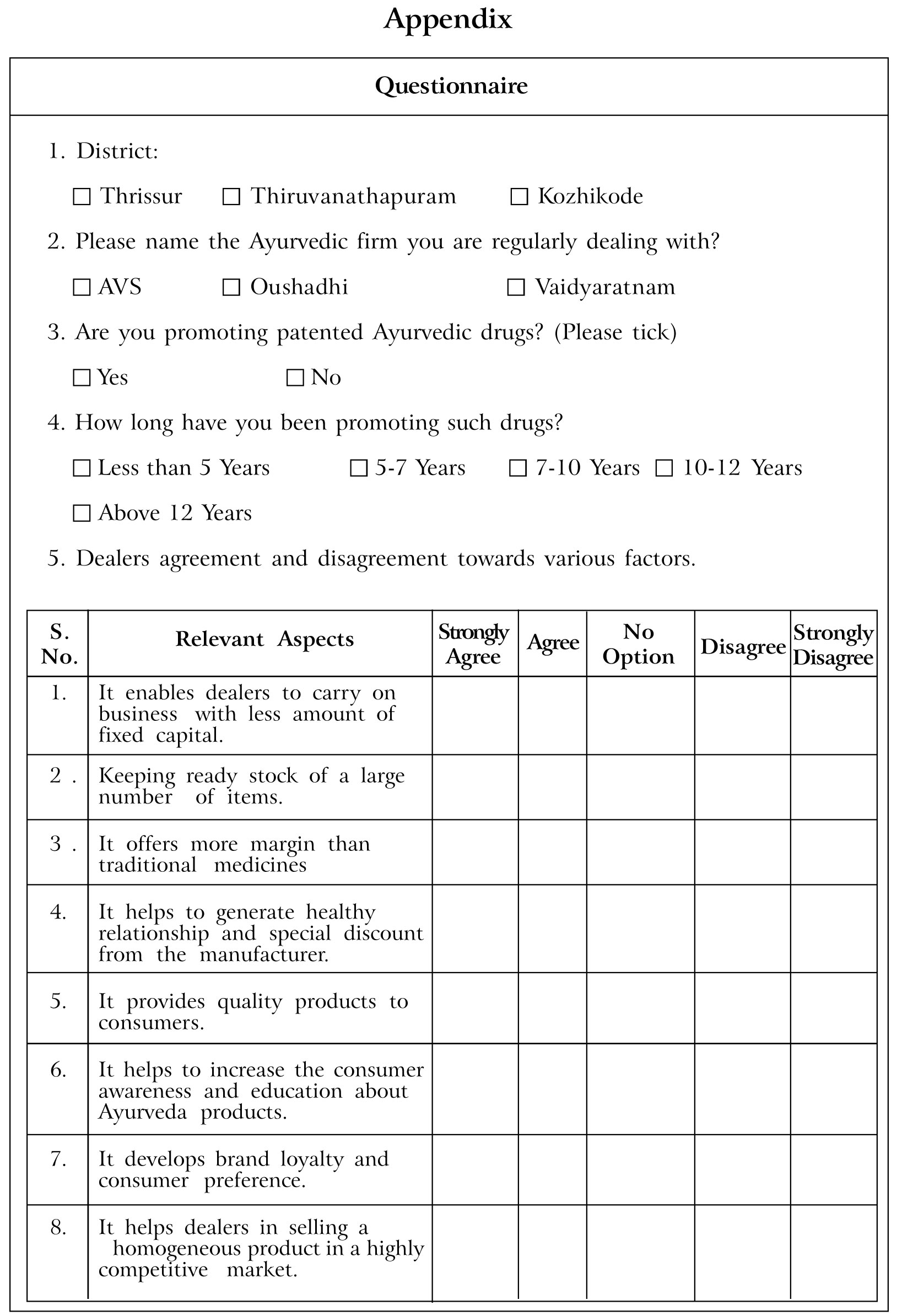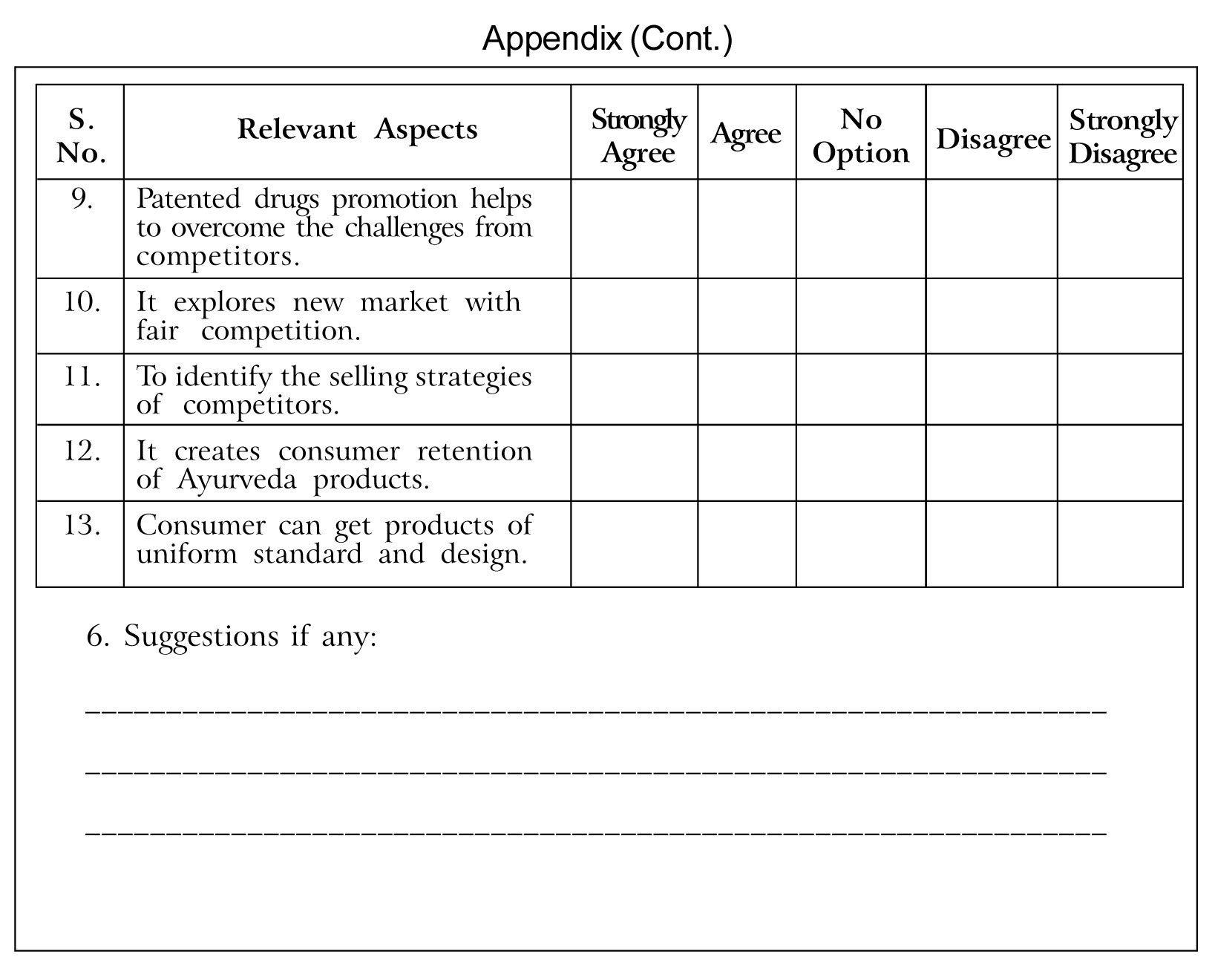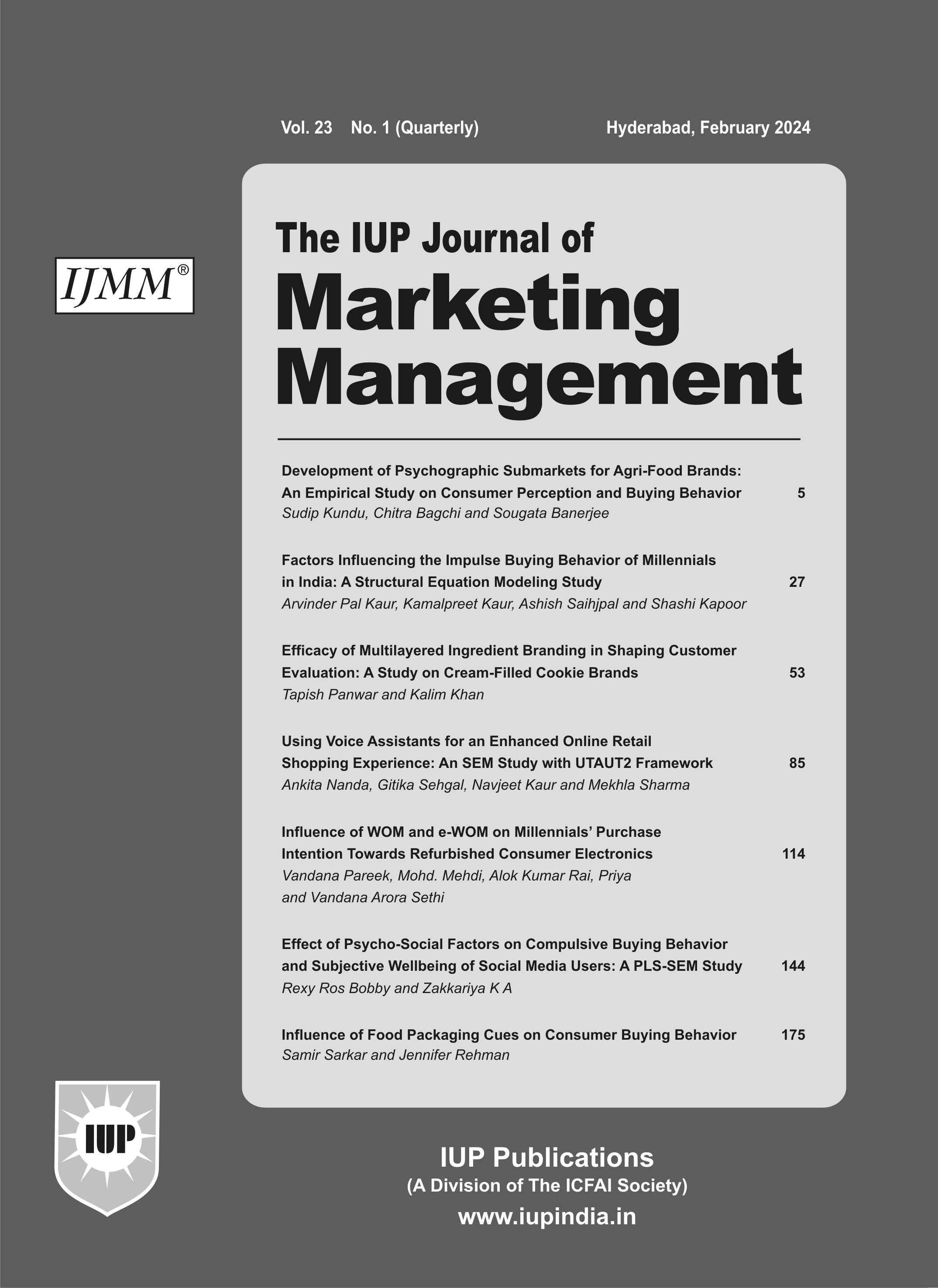
Aug' 21
The IUP Journal of Marketing Management
Archives
Factors Influencing the Promotion of Patented Ayurvedic Drugs by Ayurvedic Dealers in Kerala
Vipin Benny
Assistant Professor, Research and Post Graduate Department of Commerce, St. Thomas' College (Autonomous), Thrissur, Kerala, India. E-mail: vipinbenny5@gmail.com
In Ayurveda, Ayurvedic product dealers are promoting patented drugs along with traditional medicines. The manufacturers, along with respective sales force, are making valid attempts to inform doctors about their patented drugs. The dealers have maintained a direct relationship with the consumers in the market. They can easily identify the reactions of consumers in the usage of different products. The dealer's satisfaction has played a vital role in the marketing of patented drugs. This study investigates the factors that have influenced Ayurveda dealers to promote patented drugs in the market. It is based on 270 sample units of Ayurveda dealers in the state of Kerala. The results obtained indicate that competitive advantage, financial incentives and consumer satisfaction have greater influence on the promotion of patented drugs in Kerala.
Introduction
The 21st century witnessed a revolution in the Ayurveda sector, especially in patented medicines. There are Ayurvedic medicines that relieve knee pain, lower back pain, pores and skin care illnesses and hair issues, which are the highlights of its success. This is largely due to the scientific innovation in patented medication. In contrast, it is estimated that patent medicine is widely available even in remote areas. It is affordable to a large section of the population on account of its local availability and cost advantages. Nowadays, Ayurveda firms are turning to patented drugs with a view to reducing cost and improving return on investment. The effective traditional medicines can easily be converted into patented ones as per the regulation under the law. In the recent past, patented has been dramatically remodeling the sphere of Ayurveda. It extends extra convenience and more than one alternative to consumers. The patented tablets are advertised through manufacturers to gravitate an increasing number of clients to Ayurveda besides advertising their logos. Ayurvedic patented drugs come in diverse forms. The major ones are in the form of tablets, pills, powders, fermented products (Asava-Arishta), decoctions and medicated fats (Ghrita and Tel). For topical use, drops, creams, lotions, liniments and ointments are to be had. Dried plant extracts in pill shape are also in use (Sharma, 1987).
Human society has always dreamed of an affordable health system. Modern system of medicine has made rapid strides often with magical solutions for problems of health. But they are very expensive and sometimes unaffordable to the public. In this context, Ayurveda is of particular importance as it is supposed to be a socially relevant medical system. Ayurveda has always adhered to a code of conduct for a healthy mind in a healthy body. Because of its impact on society, people began to practice yoga, meditation, self-regulation, and moderation. Therefore, Ayurveda has a strong tradition and a sober effect on human beliefs (Tara, 2002). At present, classical drugs have been replaced by patented drugs, which has paved the way for patented drugs in the international market. The patentability created an identity for Ayurveda medicines not only in the domestic market, but at the global level also. Patents remind that standardization of raw drugs is an absolute necessity, because to get standardized product, use of standardized raw materials is essential. Nowadays, major firms promote their patented drugs through their respective dealers. In the current market, the dealers have promoted certain categories of drugs with an intention to get incentives. So, it is necessary to find whether it is the only reason to promote patented drugs in the market and whether they agree with the quality of drugs available in the market. In this context, there is a need to investigate the factors that encourage them to promote patented drugs.
Literature Review
The knowledge of doctors, dealers and pharmacists are essential for the distribution of a medicine. Serious attention must be given by the manufacturers while imparting knowledge to different categories of people associated with the distribution of medicines. Sometimes doctors prescribe unwanted medicine to patients due to lack of knowledge. Serious attention is necessary to overcome such problems related to prescription. A study was conducted in Mumbai to find the relationship that existed between pharmacy owners, medicine wholesalers and pharmaceutical sales representatives who influence the actions of pharmacy staff in the distribution of pharmaceutical drugs. It was found that economic rationale and symbiotic relation exist between doctors, medicine wholesalers and retailers in the distribution of medicines in different markets (Vinay and Mark, 1998).
Meera (2006), in her study conducted in Mumbai, measured the impact of advertising in the marketing of major medicines. It was found that advertisements have played a significant role in the sale of medicines. The study also revealed that minor ailments were treated without doctor's consultation and major ailments with doctor's prescription. Today, many consumers do not have enough time to visit doctors for the treatment of their minor ailments and resort to Over-The-Counter (OTC) medicines. It is alarming for the manufacturers to observe the behavior of consumers with regard to the affordability and acceptability of the medicines available in the market (Meera, 2006). Also, nowadays, manufacturers are interested in brand building and increasing their brand equity. They have to spend huge amounts on advertising of a particular medicine depending on their area. The rural areas require relatively smaller amounts compared to urban areas. With respect to advertising, the government has imposed certain restrictions on advertisement of new medicines. The legal implications and procedures prescribed by the government will negatively influence the brand building process of manufacturers. Also, it is time-consuming to measure the success of new medicines available in the market. In modern marketing, brand building process is strategic marketing activity, and it plays an important role in marketing of the product successfully (Gulshan, 2003). The intermediaries, especially like the doctors and dealers, have played a significant role in the prescription and promotion of medicines in a particular market. The dealers are specifically interested to sell medicines through OTC along with doctor's prescription. So the marketing strategies adopted by the manufacturers also affect the sales of dealers. Therefore, rational strategies were adopted by manufacturers to support their dealers in the market. Similarly, they have to maintain good contact with their doctors through their various sales force. This sales force acts as the link between doctors and pharmaceutical companies. The effective and rational marketing strategies adopted by the manufactures provided wide opportunities to increase the sale of medicines (Deepak, 1998). The role of pharmacist is also influenced by the process of distribution of pharmaceutical drugs. A wide range of drugs are properly stored in particular places for distribution to the dealers. Qualified pharmacists are essential to complete the procurement of medicines at appropriate places. They ensure the quality of drug, delivery, patient compliance and monitoring of medicines. However, pharmacists have to develop their expertise and facilities in order to deliver high-tech and individually-tailored medicines in the primary care settings. The OTC drugs are a success in the market due to the attitude developed by the pharmacists and the support provided to the manufacturers (Satwinder, 1983).
Vijay (2007) conducted a study in different parts of Mumbai (the sample included doctors, dealers and consumers above 18 years) to determine the extent of self-medication and consumers' attitude towards OTC medicines in India. It was found that doctors have negligible interest in OTC drugs manufactured in the market. The dealers positively support the marketing of OTC drug categories like tablets, oils and liquids through advertising, especially television advertising. Consumer demand for OTC drugs has increased, despite the regulation imposed by the government (Bhangale, 2007). There are studies conducted in the Asia-Pacific region regarding marketing strategies for OTC drugs. It has been found that OTC drugs are growing in demand in Asia. Smarta (2005) conducted a study on three segments, viz., doctors, pharmacists and patients. They are all generally in support of the OTC usage of drugs that are available in the market. According to the researcher, the challenges were lack of harmonization of regulatory practices; rational lowered tariff and duties and pricing policies should be developed for the smooth flow of medicines and finally uniform taxation policy should be implemented throughout India. The effectiveness of marketing strategies was measured through the attitude of consumers, dealers, doctors and pharmacists (Mayyada et al., 2005; and Smarta, 2005).
A few studies were conducted to identify the most important source of awareness related to pharmaceutical medicines and attitude of doctors towards OTC drugs. It is found that certain categories of consumers are interested in buying OTC categories only through doctor's prescription. Sometimes chemists have adequate awareness about the various categories of drugs. It enables the consumers to buy the drug in a less expensive manner, that is, without doctor's consultation. The doctors and chemists are the major source of awareness about the new drugs available in the market (Bradley et al., 1998). Another study was conducted to analyze the behavior of physicians in prescribing OTC products. It was conducted based on a survey of 181 physicians from West Virginia by using mailed questionnaires. The study revealed that major categories of experienced doctors are not interested in OTC usage of drugs and they are ready to stop prescription of OTC drugs (Madhavan and Gore, 1994).
Objective
Kerala has a strong tradition in the history of Ayurveda medicines. Most of the Keralites have been using Ayurveda products of different firms since time immemorial. In the current scenario, the manufacturers sell their patented drugs along with traditional medicine. There has been a tremendous growth in the production of patented Ayurvedic drugs for the past 10 years in Kerala. It is essential to know how the patented drugs create a market for Ayurveda industries and also to identify the effect of patented drugs on Ayurveda sector. The attitude of the dealers towards patented drugs is a major factor influencing the manufacturers to make patented drugs. It is necessary to investigate how far patented drugs have influenced Ayurvedic habits among the people. It is relevant for the Ayurveda firms to identify the factors that influence the dealers in promoting patented drugs. The following objectives are examined.
- To determine the factors that encourage dealers to promote patented drugs.
- To find out the relationship between the various factors and the dealers' role in the promotion of patented drugs.
- To identify the ranking of these factors that influence the dealers in promoting patented drugs.
Data and Methodology
This study is a descriptive one based on primary data. A well-structured questionnaire (see Appendix) has been used to collect the data. The questionnaire has been designed for the dealers and the questions are framed after consulting with experienced dealers and doctors in the field of Ayurveda. The questionnaires are validated by conducting a pilot study. The reliability test was conducted for the data available through questionnaire. Cronbach's alpha reliability test was conducted to measure the reliability of the data. The data set of questionnaire and its Cronbach's alpha was 0.823.
The population for this study is enormous and spread across the territory of Kerala. A sample study has been done and multi-stage sampling technique has been used in this examination.
In the primary phase of inspecting, the Ayurveda producing units from 14 districts in Kerala were taken from government sources1 and it was noticed that each region has a distinctive number of assembling units.2 Here, the assembling units are of varying size, thus, a simple random sampling is not an appropriate technique; it has been ensured that the sample selection technique adopted is in proportion to the size of the units. Probability Proportional to Size (PPS) sampling method through Lahiri's technique (Mukhopadhyay Parimal, 2014b) guarantees meeting the prerequisite of sample districts, and the three districts selected are Thrissur, Thiruvananthapuram and Kozhikode through PPS strategy.
In the second stage, the researcher identified the large-scale Ayurveda makers in Kerala with respect to the year of establishment and number of patent drugs produced by them3. The author tracked down 13 largescale Ayurveda manufactures situated in Kerala with various number of patent medications.4 Thus, the author again used PPS sampling through Lahiri's strategy for the determination of sample firms, and three firms, Arya Vaidya Sala, Oushadhi and Vaidyaratnam, have been selected for the study.
In the third stage, district-wise selection of dealers has been done through equal allocation of stratified sampling procedure. In the fourth and last stage, firm-wise selection of dealers has been conducted through the proportional allocation of stratified sampling (Mukhopadhyay, 2014a) method. Here, the firm-wise selection of dealers has been done in the proportion of their patented drugs offered by these firms, i.e., 43: 18: 14 (43 patented drugs from Arya Vaidya Sala, 18 from Oushadhi and 14 from Vaidyaratnam).
Finally, 270 dealers (52 dealers of Arya Vaidya Sala, 21 dealers of Oushadhi and 17 dealers of Vaidyaratnam from three districts) have been selected through purposive sampling. The period of data collection related to this study is from December 2020 to February 2021.
Results and Discussion
For the purpose of finding the factors influencing the promotional aspect of the dealers, factor analysis has been carried out, and multiple regression has been used to measure the functional relationship between the variables. A five-point Likert scale is used to collect the data from the respondents and the respondents were asked to rate their opinion from strongly agree to strongly disagree.
Table 1 shows the results obtained from 270 dealers. The Kaiser-Meyer-Olkin measure of sampling adequacy was conducted to determine the variables suitability for factor analysis. Here, the KMO value is 0.759, which is greater than 0.7 and Bartlett's test is significant at 5% level of significance. It indicates that 13 variables related to various factors are suitable for factor analysis.
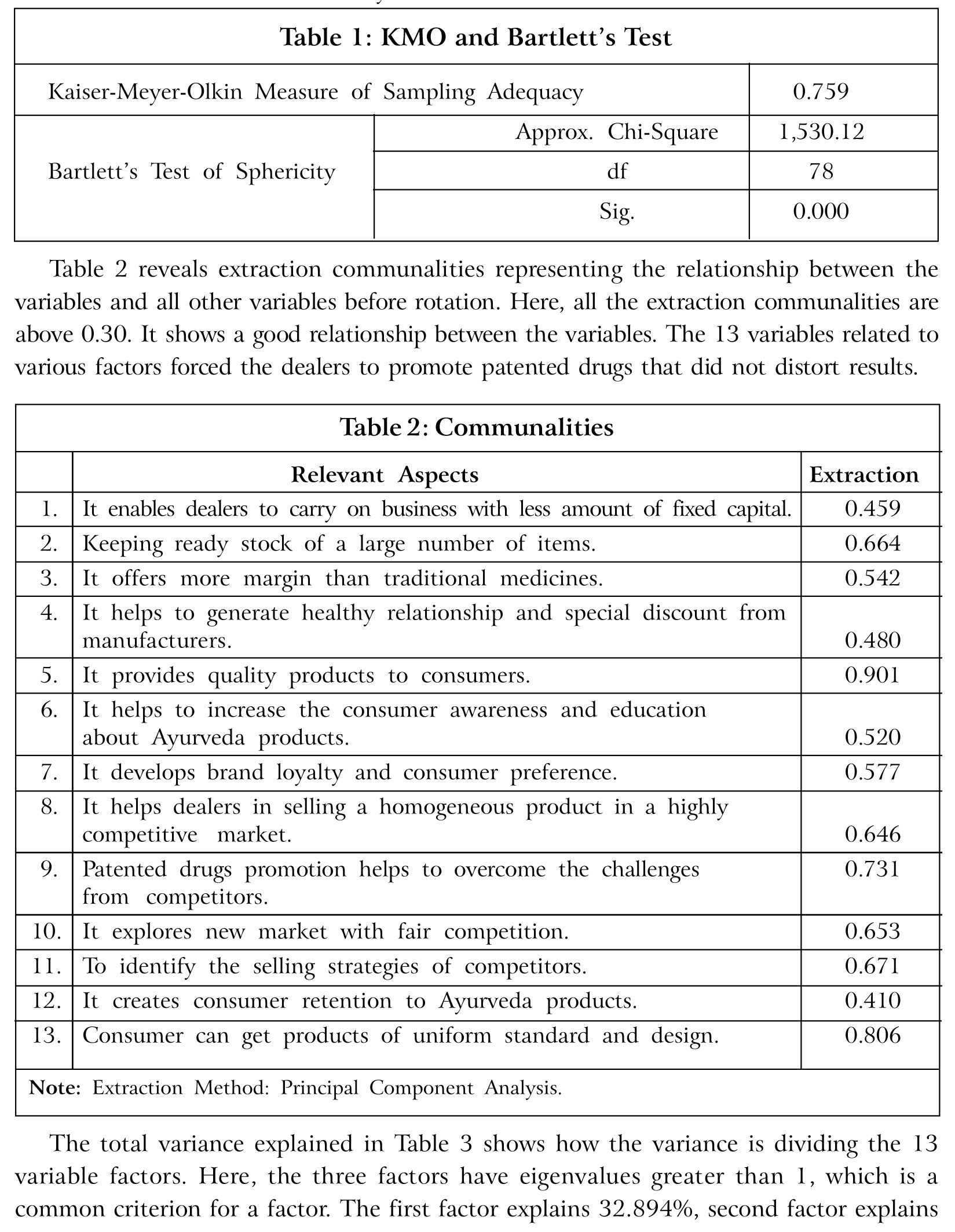
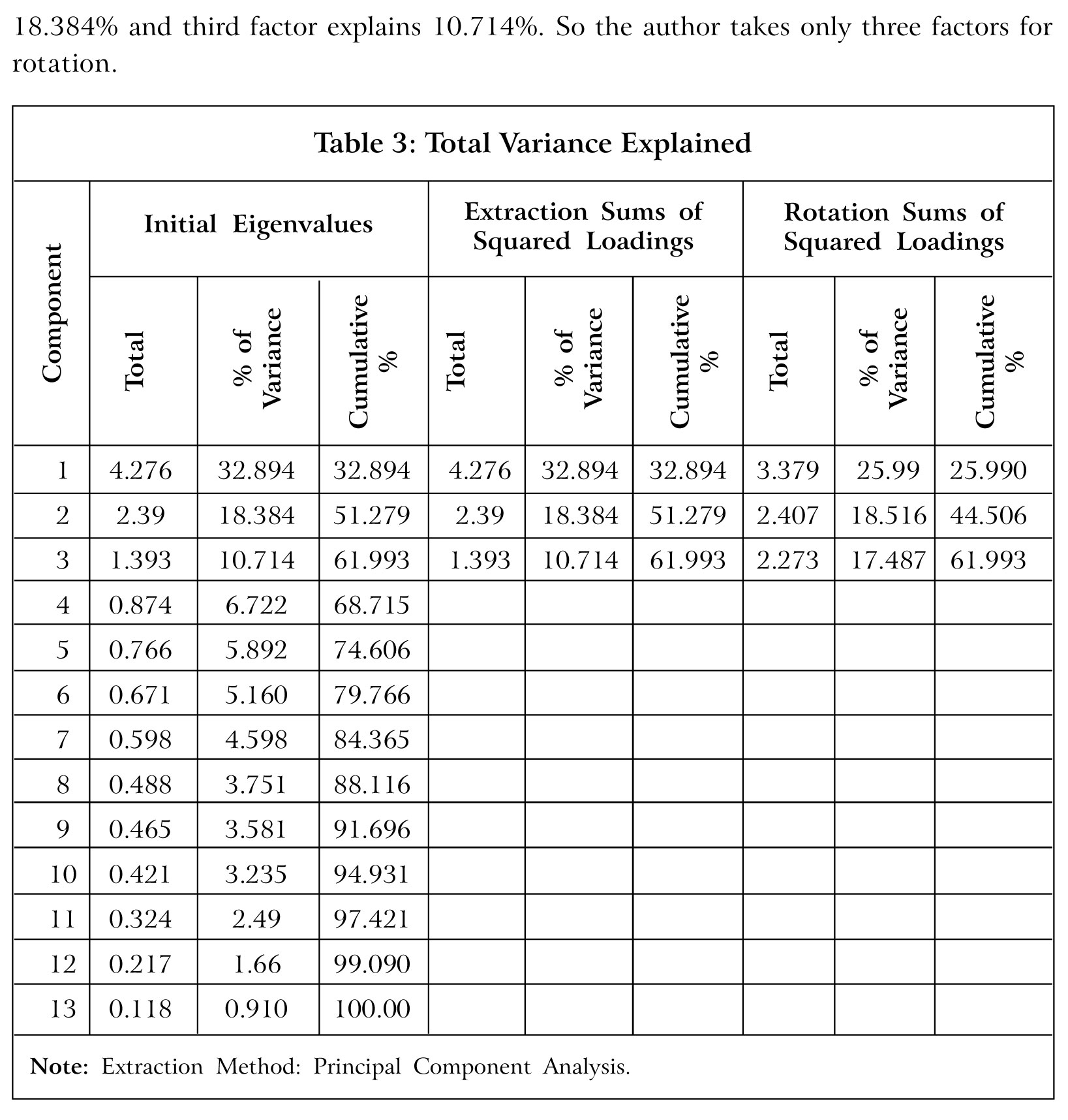
From the rotated component matrix, the first three eigenvalues (4.276, 2.39 and 1.393) of rotation matrix of 13 variables are taken, which suggests a factor solution with three factors is presented in Table 4. The factor loadings are estimated by principal component factor analysis method. In the first factor, the 8th, 9th, 10th, 11th and 12th variables have heavy loadings with an eigenvalues of 4.276, which explains 32.894% of variation. This factor is called competitive advantage. The second factor, 1st, 2nd, 3rd and 4th variables have high loading with an eigenvalues of 2.39 which explain 18.384% of variation and it is termed as financial incentives. The third factor, 5th, 6th, 7th and 13th variables have high loading with an eigenvalues of 1.393 which explains 10.714% of variation. This factor is labeled as consumer satisfaction. The total variance explained by the three factors together is approximately 61.993%.
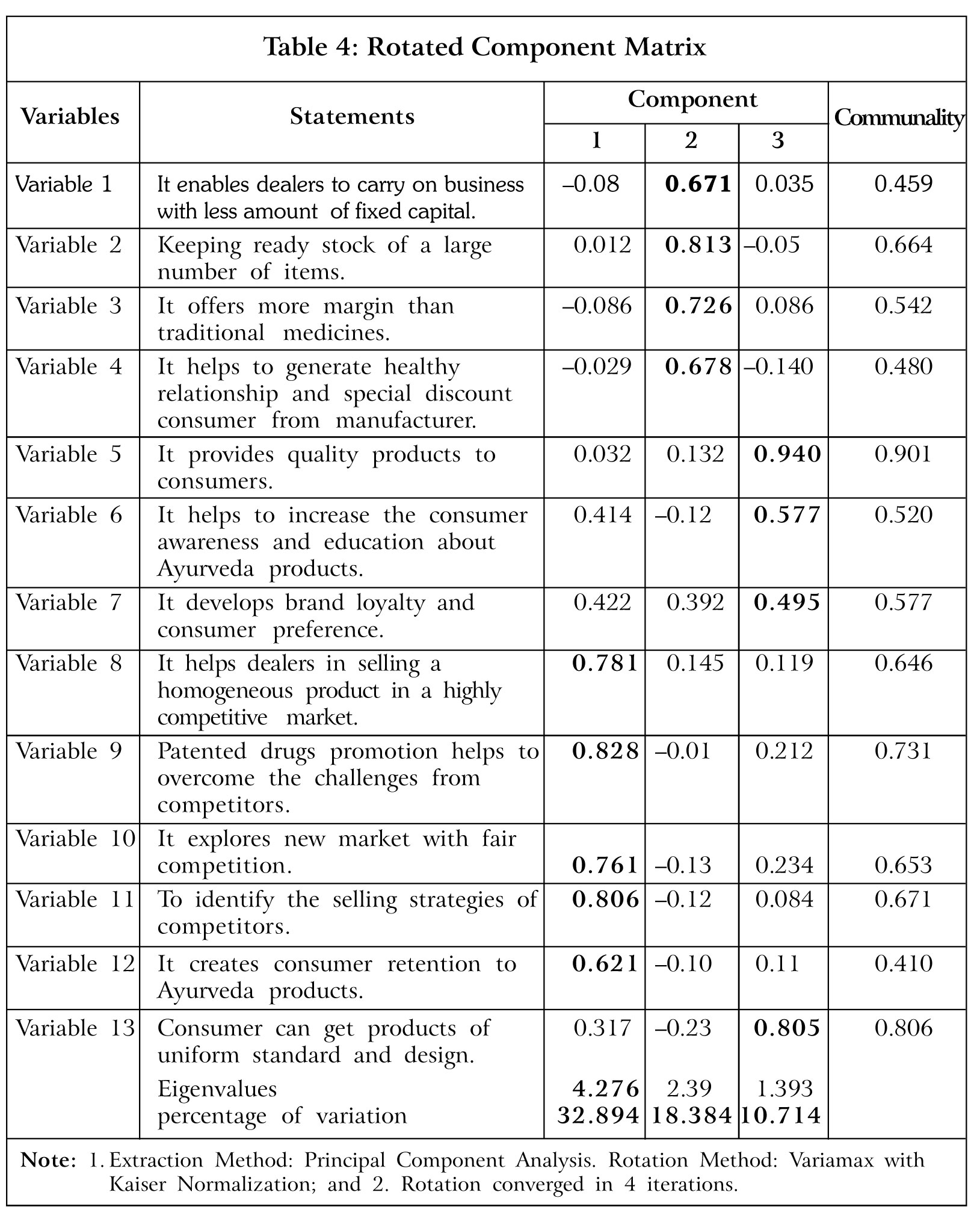
Ranking of Promotion Factors
The factors are ranked in order to know the order of preference of dealers in promoting patented drugs. The first factor considered by the dealers is competitive advantages upon which most of the decisions are taken. The variables affecting this factor are ranked based on their factor loadings. In order of their ranks, the first rank is 'patented drugs promotion helps to overcome the challenges from competitors', which means that it is the most influential factor upon the competitive advantages (Table 5).
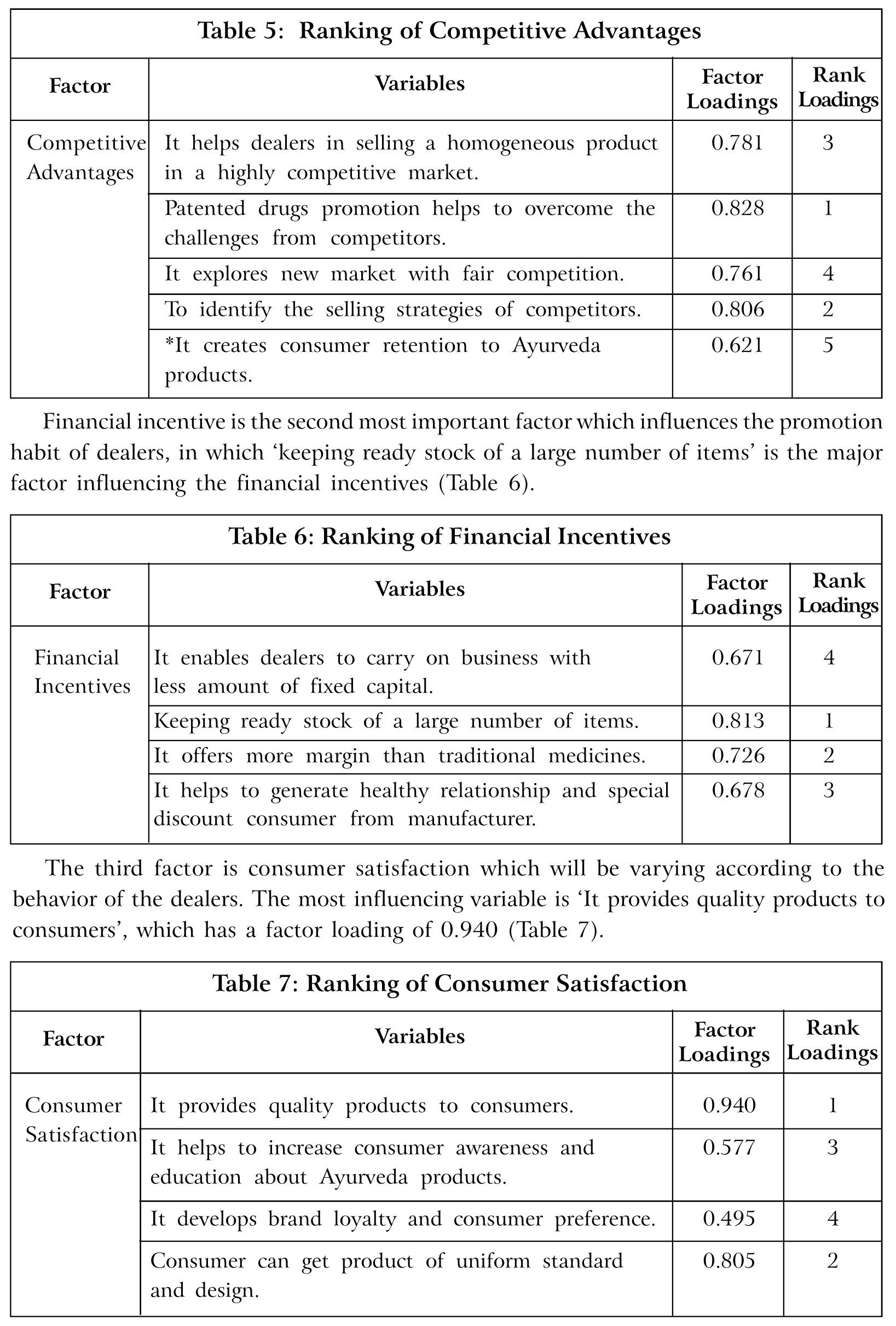
Relationship Between Factors and Promotion Practice of Dealers
For the purpose of knowing whether there is any association between the factors and the promotion practice of dealer, regression analysis was conducted and the results are discussed below.
In this stage, the author checked where the three factors were located through factor analysis with respect to their promotion practice. The regression analysis was conducted to establish the relationship between the three variables and dealers' promotion of patented drugs.
Hypothesis (Ho): There is no significant relationship between various factors and the promotion of patented drugs.
Table 8 shows the model summary of the relationship between the dependent variables and the independent variables (predictors). In this situation, promotion of patented drug is dependent variable, and competitive advantages, financial incentives and consumer satisfaction are independent variables. The model summary 'R' expresses the simple correlation between the independent variables, i.e., predictors. Here, the R value is 0.804, which indicates a high degree of correlation between the variables. The R-square value represents how much of the total variation in promotion of patented drugs (dependent) can be explained by the independent variables like competitive advantages, financial incentives and consumer satisfaction. In this situation, 64.6% of variation can be explained with the help of independent variables..
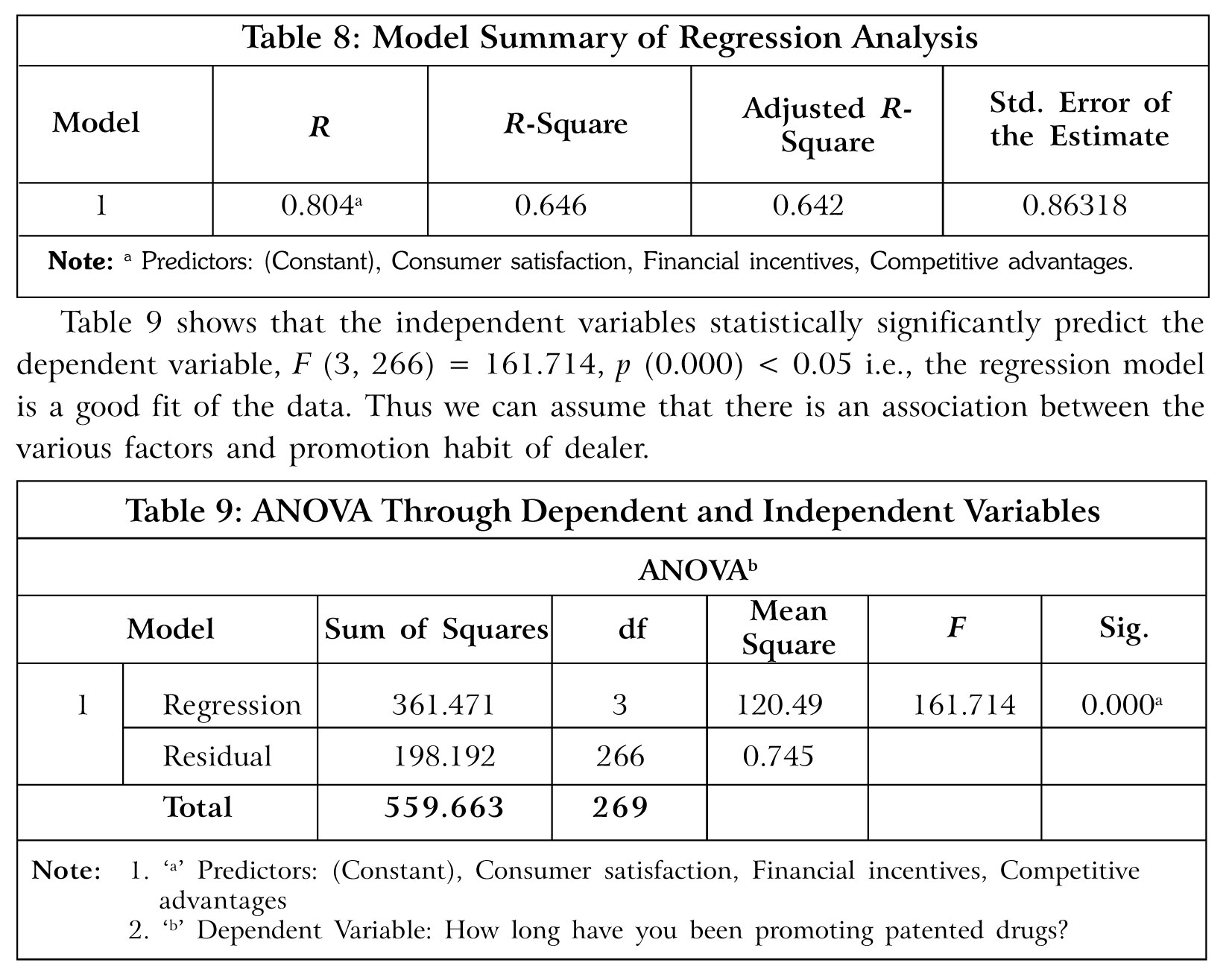
The p-value is less than 0.05 and it indicates that the regression model is statistically significant to predict the promotion of patented drugs.
Table 10 shows that the promotion of drugs increases due to increase in competitive advantages, financial incentives and consumer satisfaction. The
p-value of B coefficient is less than 0.05. So the coefficients are statistically significant..
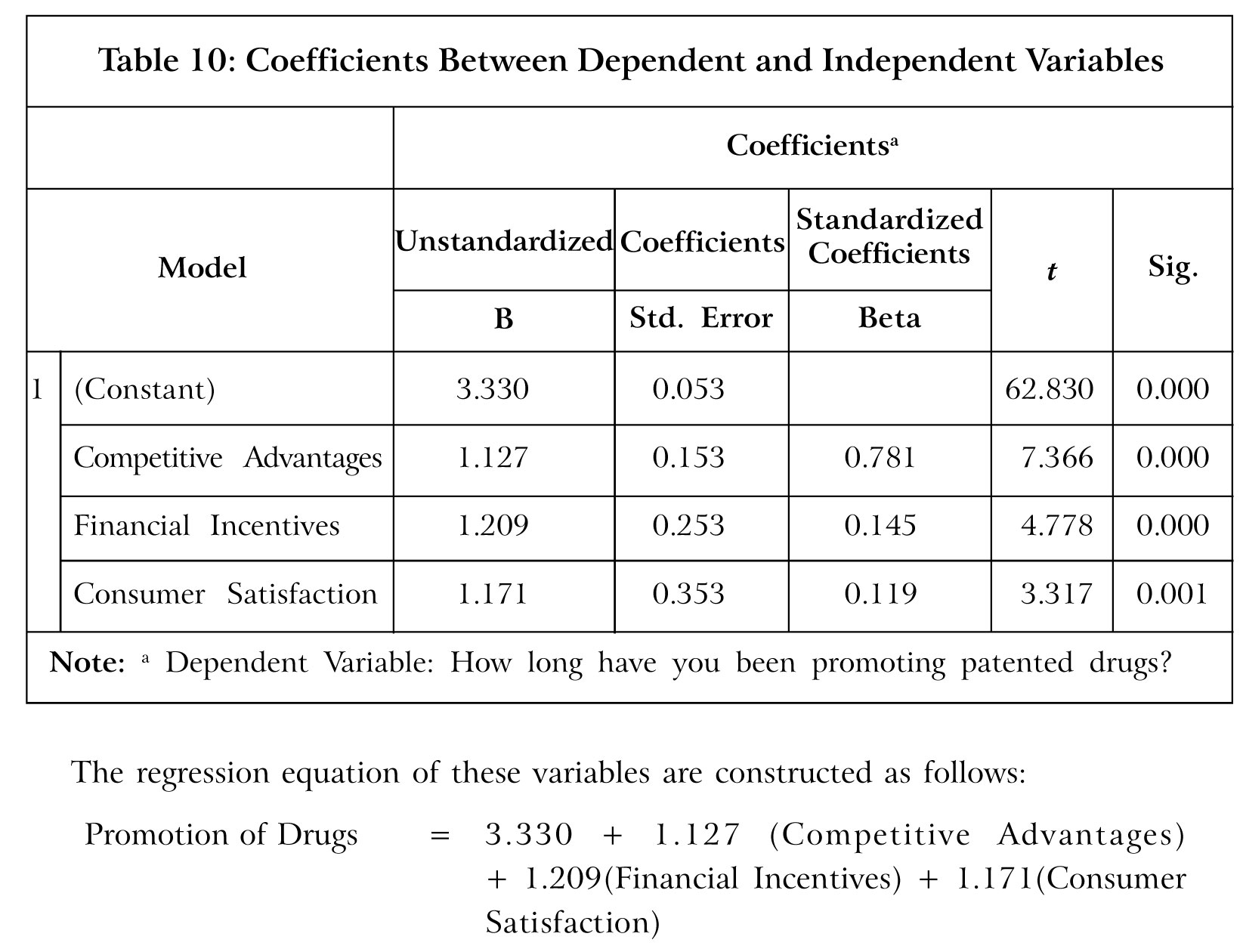
The equation is constructed with the help of dependent and independent variables. Here, Y represents promotion of patented drugs. The promotion of patented drugs is related to how long they have been promoting such drugs. The promotion tenure ranges from less than 5 years, 5-7 years, 7-10 years, 10-12 years and above 12 years. As per this study, the dealers' promotion habit has been analyzed through the questionnaire (question no.4). It was found that 18.1% of dealers have promoted patented drugs within the last 5 years, 14.4% of dealers have 5-7 years' experience, 7.4% of dealers have 7-10 years' experience, 36.4% of dealers have 10-12 years' experience and 23.7% of dealers have above 12 years' experience in promotion of patented drugs (Table 11). The regression analysis suggests that the factors competitive advantages, financial incentives and consumer satisfaction are positively related with the promotion of patented drugs. Finally, the author concludes that there is a significant relationship between various factors and promotion of patented drugs.
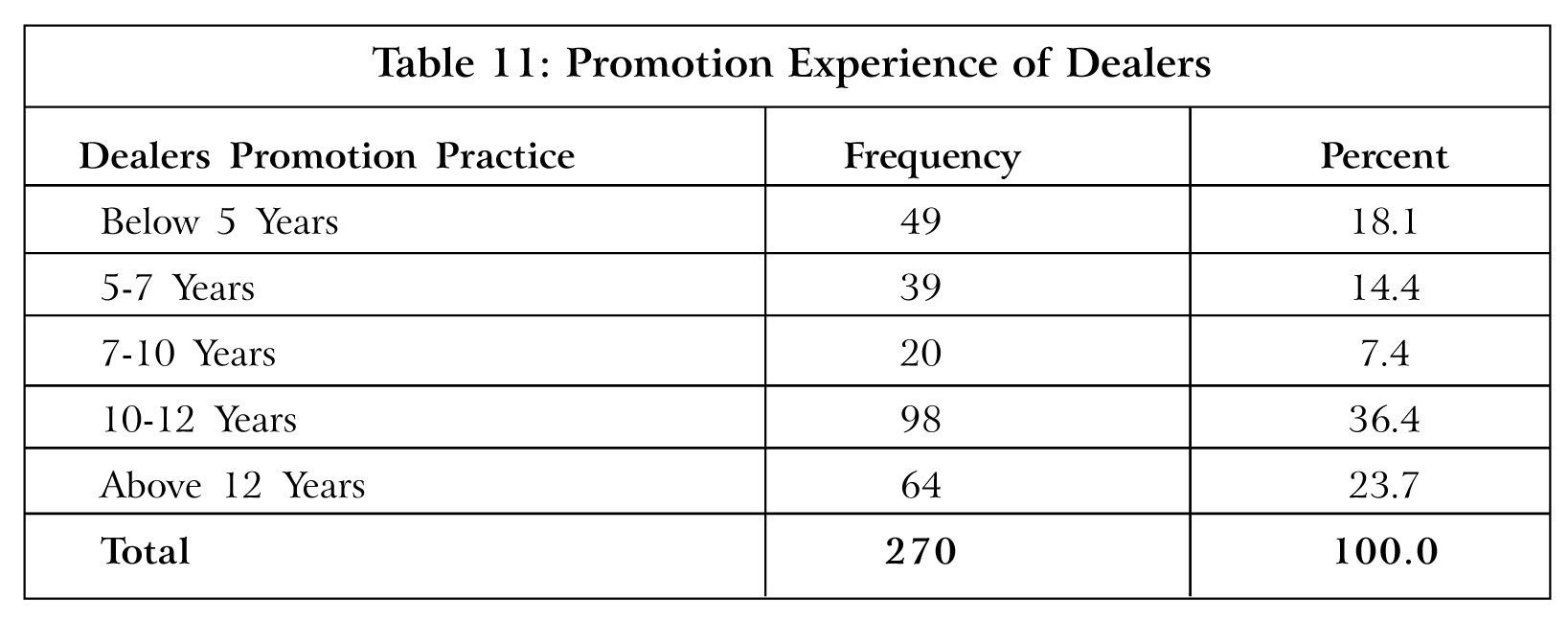
Consumer satisfaction implies confidence of the consumers in the Ayurvedic patented drugs. It has been found that as the consumer satisfaction increases, dealers' promotion practice also increases. Similarly, competitive advantages and financial incentives are also found to have a positive influence. The association between these factors and promotion practice of patented drugs has been proved using regression analysis. As the relationship has been identified between factors and the promotion practice, we fail to accept the null hypothesis that there is no association between these factors and promotion.
Conclusion
This study aims at determining the factors that influence the promotion of patented drugs. The results have pointed out three important factors, namely, competitive advantages, financial incentives and consumer satisfaction, that influence promotion of patented drugs. It is further found that there is a huge connection between these variables that force the dealers to promote patented drugs in the market. The dealer's promotion of patented medicines has improved mostly in the past two years. It is a positive sign to the manufacturers to focus on Ayurveda patented medicines. Unfortunately, the State government's approach is obstructive in nature when it comes to giving patents to Ayurveda medicines. It will demoralize the Ayurveda firms in Kerala. Nowadays, Kerala's Ayurvedic drug producers are looking for greener pastures for growth. The day is not far when we have to purchase and sell Ayurvedic drugs from outside the State of Kerala. J
References
- Bhangale V (2007), OTC Marketing of Drugs, pp. 397-402, IIM Kozhikode, Kozhikode. Retrieved from http://dspace.iimk.ac.in/bitstream/handle/2259/648/pp. 397-402.pdf?sequence=1
- Bradley C, Riaz A, Tobias R S et al. (1998), "Patient Attitudes to Over-the-Counter Drugs and Possible Professional Responses to Self-Medication", Family Practice, Vol. 15, No. 1, pp. 44-50, available at https://doi.org/10.1093/fampra/15.1.44
- Deepak Udgaonkar (1998), "A Study of Problems of Intermediate Channel In Sangli District", Ph.D. Thesis Submitted to Shivaji University Kolhapur.
- Gulshan Gidwani (2003), "Marketing Management in Pharmaceutical Industry with Special Reference to Bombay City", PhD thesis in Chapter 2 Submitted to Poona University.
- Madhavan S and Gore P R (1994), "Influence of Physicians' Attitudes Toward Rx-to-OTC Switches on Their Prescribing Behavior and Overall Judgment of Switch Appropriateness", Journal of Pharmaceutical Marketing & Management, Vol. 8, No. 1, pp. 55-84, available at https://doi.org/10.3109/J058v08n01_05
- Mayyada Wazaify, Eileen Shields and Carmel M Hughes J C M (2005), "Societal Perspectives on Over-the-Counter (OTC) Medicines", Family Practice, Vol. 22, No. 2. Retrieved from https://scholar.google.co.in citations?user =IeEBdYkAAAAJ&hl=en
- Meera Vijay (2006), "A Study on Impact of Direct to Consumers Pharmaceutical Marketing Under Indian Condition", Ph D Thesis Submitted to Bharati Vidyapeeth University, Pune.
- Mukhopadhyay Parimal (2014a), The Theory and Methods of Survey Sampling - Stratified Sampling, (Mukhopadhyay Parimal, Ed.) (2nd ed.), PHI Learning Private Limited, New Delhi. Retrieved from https://www.amazon.in/Theory-Methods-Sampling-PARIMAL-MUKHOPADHYAY-ebook/dp/B00K7YKDFQ
- Mukhopadhyay Parimal (2014b), Theory and Methods of Survey Sampling - Probability Proportionate Size Sampling, (Mukhopadhyay Parimal, Ed.) (2nd ed.), PHI Learning Private Limited, New Delhi. Retrieved from https://www.amazon.in/Theory-Methods-Sampling-PARIMAL-MUKHOPADHYAY-ebook/dp/B00K7YKDFQ
- Satwinder Singh (1983), "Transitional Co-operation & amp; Pharmaceutical Industry in India", Pune. Retrieved from shodhganga.inflibnet.ac.in/bitstream/10603/4346/8/08
- Sharma S (1987), "Ayurvedic Medicine: Past and Present", Krishnada Academy, Varanasi, pp. 195-197.
- Smarta R B (2005), "Marketing Strategies in Asia Pacific Region for OTC Drugs", Asia Management Summit, Singapore, Retrieved from.http://www.pharmabiz.com/article/detnews.asp?articleid=37678&scetionid=46
- Tara C P (2002), "Social Relevance of Ayurveda, in Swadeshi Science Movement", In Proceedings of the World Ayurveda Congress, pp. 31-35, Swadeshi Science Movement, Kochi.
- Vinay R Kamata and Mark Nichterb (1998), "Pharmacies, Self-Medication and Pharmaceutical Marketing in Bombay, India", Social Science & Medicine, Vol. 47, No. 6, pp. 779-794, available at https://doi.org/10.1016/S0277-9536(98)00134-8.
